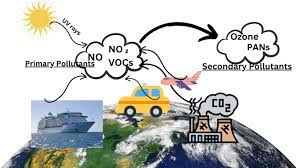Q. Discuss in detail the photochemical smog emphasizing its formation, effects and mitigation. Explain the 1999 Gothenburg Protocol.
Ans:
Photochemical Smog: Formation, Effects, and Mitigation
Formation: Photochemical smog is a type of air pollution that forms in urban areas with high levels of vehicular and industrial emissions, abundant sunlight, and stagnant atmospheric conditions. It is primarily composed of ground-level ozone (O3), nitrogen dioxide (NO2), volatile organic compounds (VOCs), and other pollutants.

Formation
- Emissions: Vehicles, industries, and other sources release nitrogen oxides (NOx) and VOCs into the atmosphere.
- Sunlight: Sunlight provides energy to initiate photochemical reactions.
- Ozone Formation: Sunlight breaks down NO2 into nitrogen monoxide (NO) and an oxygen atom (O), which then react with O2 to form ozone (O3). VOCs also undergo reactions with oxygen atoms to produce peroxyacyl nitrates (PANs) and other oxidants.
- Chemical Reactions: Ozone and PANs further react with VOCs to create secondary pollutants, including aldehydes, ketones, and organic acids.
- Stagnant Conditions: Lack of strong winds or atmospheric mixing traps pollutants near the ground, leading to the accumulation of smog.
Effects
Photochemical smog has numerous adverse effects on human health, the environment, and materials:
- Respiratory Issues: Ground-level ozone and other smog components can irritate the respiratory system, exacerbating asthma, bronchitis, and other lung diseases. Long-term exposure can lead to reduced lung function.
- Cardiovascular Effects: Smog is associated with cardiovascular problems, including heart attacks, strokes, and increased blood pressure.
- Visibility Reduction: Smog decreases visibility, impacting transportation safety and scenic views.
- Crop Damage: Ozone damages plant tissues, reducing crop yields and forest productivity.
- Environmental Harm: Smog harms ecosystems by damaging vegetation, reducing biodiversity, and affecting aquatic life.
Mitigation
Efforts to mitigate photochemical smog involve various strategies:
- Emission Reduction: Implementing stricter vehicle emission standards and regulating industrial emissions helps reduce precursor pollutants like NOx and VOCs.
- Public Transportation: Encouraging the use of public transportation, cycling, and walking reduces vehicle emissions.
- Green Spaces: Creating and preserving green spaces helps absorb pollutants and improve air quality.
- Alternative Fuels: Promoting electric vehicles and cleaner fuels reduces emissions of NOx and other pollutants.
- Industrial Controls: Implementing pollution control technologies in industries reduces emissions of smog-forming pollutants.
- Traffic Management: Implementing congestion pricing, carpooling, and efficient traffic management reduces vehicular emissions.
- Awareness Campaigns: Educating the public about the effects of smog and promoting sustainable behaviors can reduce pollution.
The 1999 Gothenburg Protocol: The Gothenburg Protocol is an international agreement aimed at addressing transboundary air pollution and its effects on human health and the environment. Adopted in 1999 under the United Nations Economic Commission for Europe (UNECE), the protocol sets emission reduction targets for several pollutants, including sulfur dioxide (SO2), NOx, VOCs, and ammonia (NH3).
Key features of the Gothenburg Protocol:
- National Emission Ceilings: Countries set national emission ceilings for specific pollutants, committing to reducing their emissions below these limits.
- Flexibility Mechanisms: The protocol allows for trading emission reduction credits among countries, promoting cost-effective mitigation measures.
- Periodic Review: Countries periodically review and revise their emission reduction commitments based on scientific knowledge and technological advancements.
- Transboundary Effects: The protocol addresses the transboundary nature of air pollution, recognizing that pollutants can travel across borders and impact neighboring countries.
- Health and Environmental Objectives: The protocol aims to protect human health and the environment by reducing air pollution levels.
The Gothenburg Protocol has contributed to improved air quality and reduced emissions of smog-forming pollutants in Europe, highlighting the importance of international cooperation in addressing photochemical smog and its impacts.
Thanks for reading the answer to question: Discuss in detail the photochemical smog emphasizing its formation, effects and mitigation. Explain the 1999 Gothenburg Protocol.